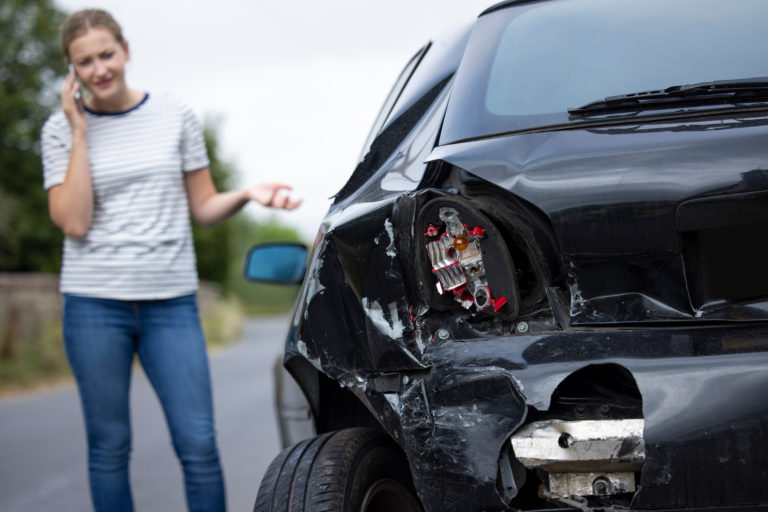Florida´s Move Over law requires drivers to move over away from stopped emergency vehicles where ever possible or to slow down to 20 mph below the speed limit or to five mph when the speed limit is 20 mph or less. The “Move Over Act”, passed during the 2002 session of the Florida Legislature, was signed by Governor Jeb Bush on May 1, 2002.
There have been several collisions recently involving law enforcement officers on the side of highways while they were conducting traffic stops in Florida. One of those resulted in the untimely death of Deputy Ryan Seguin, a 23-year-old deputy of the Broward County Sheriff’s Office. Deputy Seguin was struck and killed by a passing vehicle on February 15, 2006, while he conducted a traffic stop on Interstate 595 in Broward County.
A second incident involved Florida Highway Patrol Trooper Darryl Haywood, Jr. At approximately 7:00 on Sunday, January 22, 2006, Trooper Darryl Haywood, Jr., Troop K-Broward County, was involved in a serious patrol car crash on Florida´s Turnpike just south of the Hollywood Boulevard exit. Trooper Haywood had just stopped a motorist and was in the process of writing a citation on the west shoulder of the Turnpike when his patrol car was rear-ended by a Dodge pick-up truck that had veered from the center lane. The pick-up truck then overturned and came to final rest in the center lane of the Turnpike. It took rescue crews about 30 minutes to extricate Trooper Haywood from his patrol car. He was subsequently airlifted to Ryder Trauma Center in Miami in serious but stable condition with head injuries. Trooper Haywood has since been released and is expected to make a full recovery.
The most recent case involved Florida Highway Patrol Trooper Adam M. Heinlein. Trooper Heinlein is lucky to be alive after a tractor-trailer traveling south on U.S. 27, at about 60 miles per hour, smashed against the driver’s side of his cruiser on February 16, 2006. Heinlein was sitting in the driver’s seat, working on his computer, when the tractor-trailer sideswiped the police car. At the time of the crash, the individual who had just been stopped by Trooper Heinlein was standing near the right front fender of the patrol car. The victim received cuts on his neck from flying glass and was transported to a nearby hospital with minor injuries.
These grim incidents occurred just as FHP is getting geared up for its 3rd full-scale public information campaign to promote Florida´s Move Over Law (Ch. 316.126(1)(b), F.S.), which passed in July 2002. Many motorists still do not understand the importance of this law, which requires motorists to slow down or move over (change lanes) away from emergency vehicles stopped on the side of the roadway with lights flashing. When approaching a police car, ambulance, tow truck, or other emergency vehicle, motorists are required to follow this common sense law. FHP urges motorists to help protect the people who protect you – please move over and let emergency workers do their jobs without the risk of being injured or killed.
Here’s what the law states:
(1)(a) Upon the immediate approach of an authorized emergency vehicle, while en route to meet an existing emergency, the driver of every other vehicle shall, when such emergency vehicle is giving audible signals by siren, exhaust whistle, or other adequate device, or visible signals by the use of displayed blue or red lights, yield the right-of-way to the emergency vehicle and shall immediately proceed to a position parallel to, and as close as reasonable to the closest edge of the curb of the roadway, clear of any intersection and shall stop and remain in position until the authorized emergency vehicle has passed, unless otherwise directed by any law enforcement officer.
(b) When an authorized emergency vehicle making use of any visual signals is parked or a wrecker displaying amber rotating or flashing lights is performing a recovery or loading on the roadside, the driver of every other vehicle, as soon as it is safe: 1. Shall vacate the lane closest to the emergency vehicle or wrecker when driving on an interstate highway or other highway with two or more lanes traveling in the direction of the emergency vehicle or wrecker, except when otherwise directed by a law enforcement officer.
2. Shall slow to a speed that is 20 miles per hour less than the posted speed limit when the posted speed limit is 25 miles per hour or greater; or travel at 5 miles per hour when the posted speed limit is 20 miles per hour or less, when driving on a two-lane road, except when otherwise directed by a law enforcement officer.
(c) The Department of Highway Safety and Motor Vehicles shall provide an educational awareness campaign informing the motoring public about the Move Over Act. The department shall provide information about the Move Over Act in all newly printed driver´s license educational materials after July 1, 2002.
This section shall not relieve the driver of an authorized emergency vehicle from the duty to drive with due regard for the safety of all persons using the highway.
(2) Every pedestrian using the road right-of-way shall yield the right-of-way until the authorized emergency vehicle has passed, unless otherwise directed by any police officer.
(3) Any authorized emergency vehicle, when en route to meet an existing emergency, shall warn all other vehicular traffic along the emergency route by an audible signal, siren, exhaust whistle, or other adequate device or by a visible signal by the use of displayed blue or red lights. While en route to such emergency, the emergency vehicle shall otherwise proceed in a manner consistent with the laws regulating vehicular traffic upon the highways of this state.
(4) Nothing herein contained shall diminish or enlarge any rules of evidence or liability in any case involving the operation of an emergency vehicle.
(5) This section shall not operate to relieve the driver of an authorized emergency vehicle from the duty to drive with due regard for the safety of all persons using the highway.
(6) A violation of this section is a noncriminal traffic infraction, punishable pursuant to chapter 318 as either a moving violation for infractions of subsection (1) or subsection (3), or as a pedestrian violation for infractions of subsection (2).
$3.3 Million Settlement
Bicycle Accident
$1,000,000 Settlement
Slip and Fall
$2.5 Million Settlement
Medical Malpractice
$725,000 Settlement
Auto Accident
$3.5 Million Settlement
Defective Product
$17,400,000 Verdict
Tobacco Injuries
$1,200,000 Settlement
Construction Accident
$1,100,000 Settlement
Defective Product
$1,100,000 Settlement
Bicycle Accident
$4 Million Verdict
Auto Accident
$625,000 Settlement
Construction Accident
$1,300,000 Verdict
Medical Malpractice
Six Figure Settlement
Nursing Home Abuse
$650,000 Verdict
Trucking Accident

